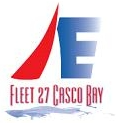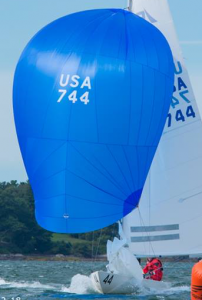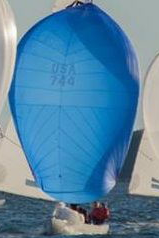THIS PAGE IS UNDER CONSTRUCTION.
A Sail Acquisition Strategy for Club Racing
An unfortunate aspect of Club racing is that success often can be bought, since many club boats are in less than top-notch form. While it might be expected that the top echelon of boats are all reasonably well outfitted, even at the top of the fleet, the condition of a boat’s sails may be the difference between winning and second or third place.
Nevertheless, one way to move up the ladder is by acquiring new(er) sails. But sails are very expensive – at the club level, new sails can cost relatively more than the boat itself. In many cases, it is often a balancing act to race with good sails, yet not be seen as buying your way to victory.
Fleet 27 members who sail in the major regattas often try to obtain gently used sails from other competitors to auction off to Fleet 27 members. These sails are often in good shape and competitive for club racing, and they are often at a very deep discount to new sails. If there are sails available through this process, the auction usually happens in the spring before the racing starts.
Another approach is to buy a new sail periodically, say a spinnaker one year, a jib another year, a mainsail in yet another year, to spread out the expense.
A good jib is probably the most important sail. It also wears the fastest. Followed by a good spinnaker. The spinnaker wears pretty fast, as well. The mainsail can be tinkered with by adjusting the mast bend controls and does not seem to wear as fast as the other sails. YMMV.
On Casco Bay, with flat water and predominantly light winds, well cared for sails can remain competitive for many years.
Well cared for means rolling the upwind sails when storing them, washing the salt off sails whenever possible, keeping the sails out of the sun when not being used, repairing any damage as soon as it happens, minimizing luffing and flogging the sails.
An advantage of buying sails new from the sailmaker is you can get the model most suited for your rig. Used sails likely were set up for the original buyer’s rig, and may not be the best fit for your rig, if you have a different brand of mast, for example.
One idea to minimize any boat’s advantages due to having new sails is for the fleet to buy sails as a group, so that everyone is on an equal footing with regards to sails. The sail purchases could be spread out, jibs one year, mainsails another, etc., or buy complete sets periodically, say every 5 years.
Spinnakers
Different spinnaker types are optimized for different purposes. Etchells spinnakers are designated as either “runners” or “VMG” (velocity made good) kites. The runners are best for sailing dead down wind, usually only done when winds are above, say 14-16 kts. The VMG is used when the boats need to sail hotter angles on a broad reach (to keep the speed made good up), at least part of the time during the leeward leg. The runner is difficult to fly in light air. The VMG can handle heavy wind reasonably well. Thus, many Etchells use only the VMG type spinnaker; and if only one kite is onboard, it is usually a VMG.
On top of this, there are the different ways of orienting and sewing the cloth panels together to control the shape of the spinnaker under load. Hopefully, you can see the panel seams in these pictures. Full radial, Tri-radial, bi-radial, cross cut, miter cut, and not seen for many years, the original vertical panels. The full radial cut is the most expensive configuration due to all the work needed to sew all those seams, and there is more wasted cloth. But, it is the most stable pattern. The tri-radial has cross-cut (horizontal) panels in the middle.
- The Full Radial Runner (left), with its big shoulders and panel seams radiating from each corner of the sail, is best for sailing fast DDW in big breeze.
- The Cross Cut (center) orients the panels horizontally to minimize wasted material. The big shoulders on the green kite indicate it is a runner.
- The Bi-Radial VMG (right) with a miter cut head presents a flatter, narrower head than the runner, yet still provides the radial load path at the clews. With its narrow head, this kite is good for light air, lumpy water.



